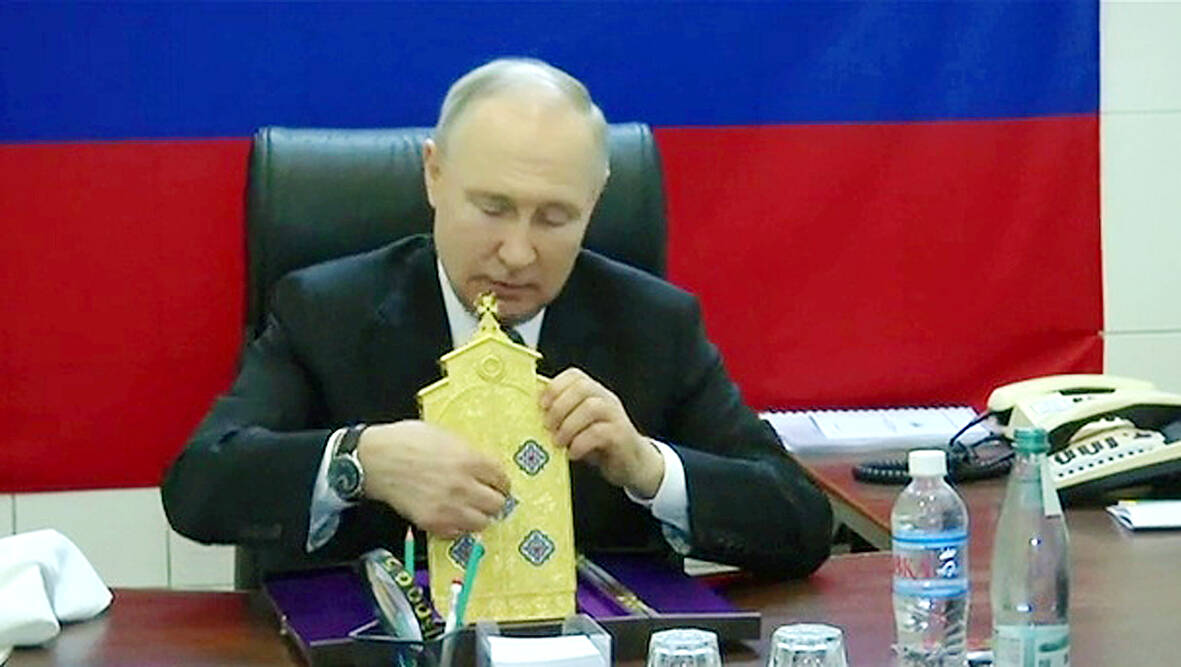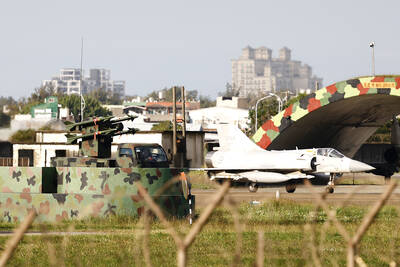Russian President Vladimir Putin visited command posts of the Kremlin’s forces fighting in Ukraine, officials said yesterday, as the war approaches its 14th month and Kyiv readies a possible counteroffensive with Western-supplied weapons.
A video released by the Kremlin and broadcast by Russian state television showed Putin arriving by helicopter at the command post of Russian forces in southern Ukraine’s Kherson province and then flying to the headquarters of the Russian National Guard in Luhansk province, which is in the east.
Kremlin spokesman Dmitry Peskov said the visits took place on Monday. The trip, Putin’s second in two months to Russian-occupied territory in Ukraine, represented an apparent attempt by the Russian leader to rally his troops and demonstrate his authority.

Photo: EPA-EFE / SPUTNIK / KREMLIN POOL
Dressed in a dark suit, Putin appeared to chair meetings with his military top brass during both of his stops. The locations of the military headquarters were not disclosed, making it impossible to assess how close they were to the front line. Nor was it possible to independently verify the authenticity of the video footage.
Ukrainian President Volodymyr Zelenskiy yesterday made his latest trip to positions near the front line to stiffen the resolve of soldiers battling Putin’s troops.
Zelenskiy visited units in Avdiivka, a city in Donetsk province where fierce battles are taking place, his office said. He heard first-hand reports about the battlefield situation and handed out awards.
Zelenskiy’s visits to areas of his country that have felt the brunt of Russia’s full-scale invasion gathered pace last month as he shuttled across the country, often by train. As with Putin, the Ukrainian leader’s wartime trips usually are not publicized until after he has already left an area.

Taiwan is gearing up to celebrate the New Year at events across the country, headlined by the annual countdown and Taipei 101 fireworks display at midnight. Many of the events are to be livesteamed online. See below for lineups and links: Taipei Taipei’s New Year’s Party 2026 is to begin at 7pm and run until 1am, with the theme “Sailing to the Future.” South Korean girl group KARA is headlining the concert at Taipei City Hall Plaza, with additional performances by Amber An (安心亞), Nick Chou (周湯豪), hip-hop trio Nine One One (玖壹壹), Bii (畢書盡), girl group Genblue (幻藍小熊) and more. The festivities are to

Auckland rang in 2026 with a downtown fireworks display launched from New Zealand’s tallest structure, Sky Tower, making it the first major city to greet the new year at a celebration dampened by rain, while crowds in Taipei braved the elements to watch Taipei 101’s display. South Pacific countries are the first to bid farewell to 2025. Clocks struck midnight in Auckland, with a population of 1.7 million, 18 hours before the famous ball was to drop in New York’s Times Square. The five-minute display involved 3,500 fireworks launched from the 240m Sky Tower. Smaller community events were canceled across New Zealand’s

‘IRRESPONSIBLE’: Beijing’s constant disruption of the ‘status quo’ in the Taiwan Strait has damaged peace, stability and security in the Indo-Pacific region, MOFA said The Presidential Office yesterday condemned China’s launch of another military drill around Taiwan, saying such actions are a “unilateral provocation” that destabilizes regional peace and stability. China should immediately stop the irresponsible and provocative actions, Presidential Office spokeswoman Karen Kuo (郭雅慧) said, after the Chinese People’s Liberation Army (PLA) yesterday announced the start of a new round of joint exercises around Taiwan by the army, navy and air force, which it said were approaching “from different directions.” Code-named “Justice Mission 2025,” the exercises would be conducted in the Taiwan Strait and in areas north, southwest, southeast and east of Taiwan

UNDER WAY: The contract for advanced sensor systems would be fulfilled in Florida, and is expected to be completed by June 2031, the Pentagon said Lockheed Martin has been given a contract involving foreign military sales to Taiwan to meet what Washington calls “an urgent operational need” of Taiwan’s air force, the Pentagon said on Wednesday. The contract has a ceiling value of US$328.5 million, with US$157.3 million in foreign military sales funds obligated at the time of award, the Pentagon said in a statement. “This contract provides for the procurement and delivery of 55 Infrared Search and Track Legion Enhanced Sensor Pods, processors, pod containers and processor containers required to meet the urgent operational need of the Taiwan air force,” it said. The contract’s work would be